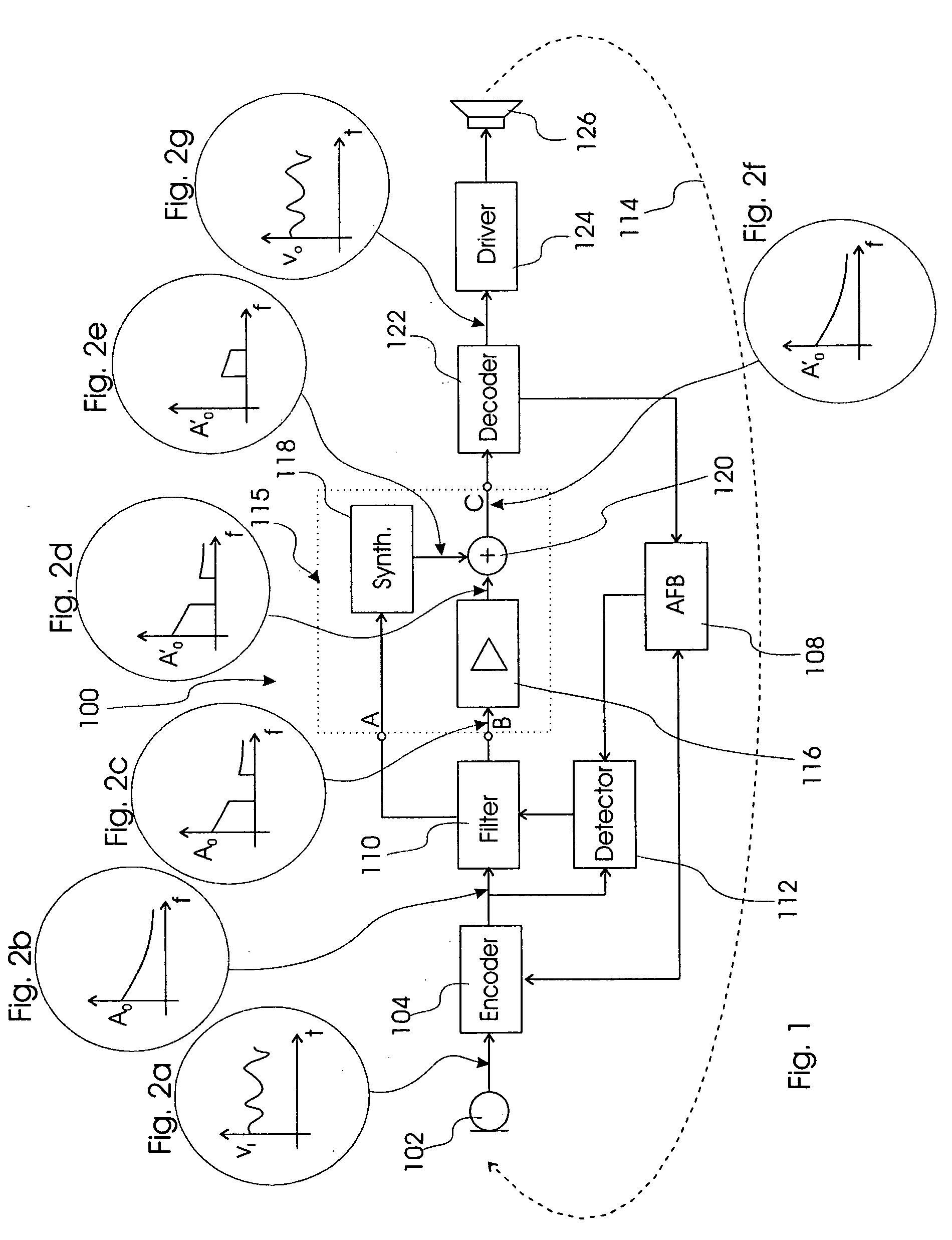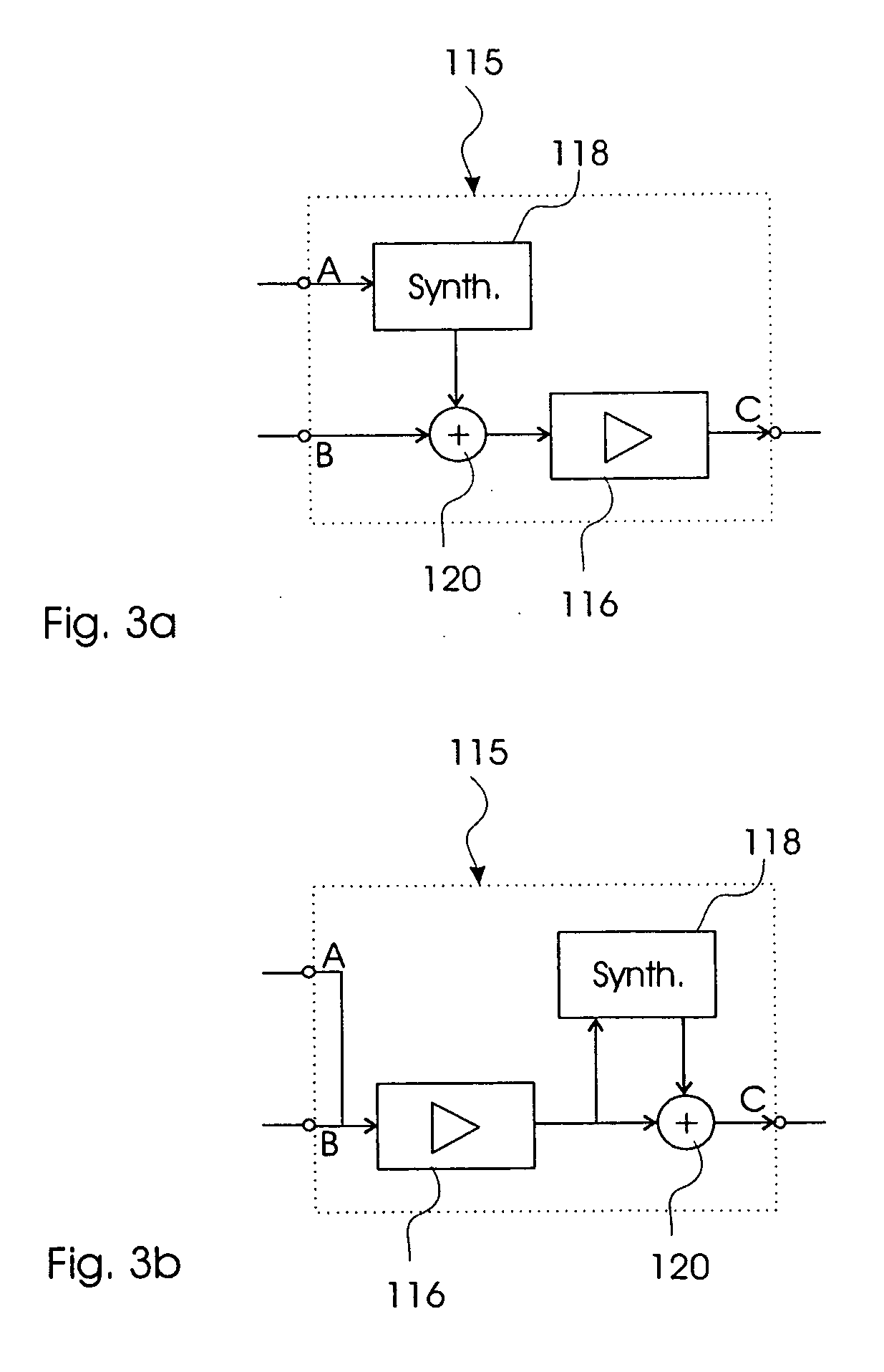System and Method for Eliminating Feedback and Noise In a Hearing Device
a hearing aid and acoustic feedback technology, applied in the field of system and method for eliminating acoustic feedback and noise in the hearing aid, can solve the problems of audible distortion of the original input signal, degrading the sound quality of the user of the hearing aid, and problems such as and achieve the effect of removing the noise in the incoming signal
- Summary
- Abstract
- Description
- Claims
- Application Information
AI Technical Summary
Benefits of technology
Problems solved by technology
Method used
Image
Examples
first embodiment
[0050]FIG. 1 shows a system for synthesizing an audio input signal according to the present invention, which system is designated in entirety by reference numeral 100. The system 100 comprises a microphone 102 converting a sound pressure into a time varying electric signal, for example such as shown in FIG. 2a. The description relating to FIGS. 2a through 2f is incorporated in the description relating to FIG. 1.
[0051]Obviously, the system 100 may comprise any number of microphones such as two or more used for determining a directionality function. However, the following description and figures show only one microphone 102 for simplicity.
[0052]The sound pressure forms an audio input signal, which is converted by the microphone 102 to the electric signal and communicated to an encoder 104. The term “encoder” is in this context be construed as a transforming, encoding and / or converting element.
[0053]The encoder 104 according to the first embodiment of the present invention comprises a ...
second embodiment
[0072]FIG. 4 shows a system for synthesizing an audio input signal according to the present invention, which is designated in entirety by reference numeral 400. Similar elements and units described with reference to FIGS. 1, 3a and 3b are designated by identical reference numerals.
[0073]The system 400 comprises a microphone 102 generating an electric signal to a processing unit 402, which processes the electric signal according to a setting stored in a memory 404 communicating with the processing unit 402. The processing unit 402 generates a processed signal, which is forwarded to a driver 124 driving a speaker 126 to generate an audio output signal.
[0074]The processing unit 402 comprises an encoder 104, an anti-feedback unit 108, a filter unit 110 and a detector 112, and a signal processing unit 115 operating as described above with reference to FIGS. 1, 3a or 3b. The detector 112 controls the filter unit 110 and forwards frequency bandwidth information to a controller processor 40...
third embodiment
[0080]FIG. 5 shows a system according to the present invention, which is designated in entirety by reference numeral 500. Similar elements and units described with reference to FIGS. 1, 3a, 3b, and 4 are designated by identical reference numerals.
[0081]The system 500 operates as described above with reference to FIG. 4, however, the system 500 comprises a processing unit 502, wherein instead of having an anti-feedback unit for generating an anti-feedback signal or feedback signal the processing unit 502 comprises a detector 112 with an howl element determining from the signal in the encoder 104 whether acoustic feedback is present in the forward signal path. Hence the system 500 entirely utilises the signal processing unit 115 for eliminating acoustic feedback; that is by removal and synthesis of a frequency bandwidth.
[0082]FIG. 6a shows a graph of a first example of a transposition of source frequency bands 2.0 to 2.5; 2.5 to 3.0; 3.0 to 3.5; and 3.5 to 4.0 kHz to four resultant fr...
PUM
 Login to View More
Login to View More Abstract
Description
Claims
Application Information
 Login to View More
Login to View More - R&D
- Intellectual Property
- Life Sciences
- Materials
- Tech Scout
- Unparalleled Data Quality
- Higher Quality Content
- 60% Fewer Hallucinations
Browse by: Latest US Patents, China's latest patents, Technical Efficacy Thesaurus, Application Domain, Technology Topic, Popular Technical Reports.
© 2025 PatSnap. All rights reserved.Legal|Privacy policy|Modern Slavery Act Transparency Statement|Sitemap|About US| Contact US: help@patsnap.com



